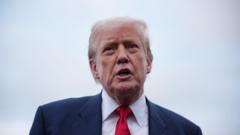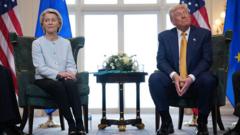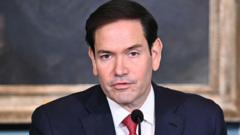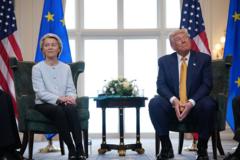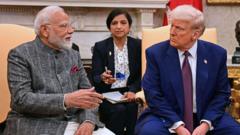With the new tariffs and trade agreements in place, President Trump claims victories in reshaping U.S. trade, but the long-term effects could pose challenges for American consumers and international relationships.
Trump's Tariff Tactics: Economic Gains or Global Repercussions?

Trump's Tariff Tactics: Economic Gains or Global Repercussions?
As President Trump celebrates his trade deals and tariffs, the implications for the U.S. economy and global trade are still uncertain.
In April, Donald Trump ignited a global response with his announcement of new import tariffs. However, most of these tariffs were quickly put on hold due to the ensuing financial panic. Fast forward four months and Trump is now asserting that several trade victories have been achieved, presenting a series of agreements with trading partners and unilaterally enforced tariffs on others, all while avoiding the massive market upheavals experienced earlier.
As Trump aims to reorder the U.S.'s role in the global economy, he promises revenue benefits, a resurgence in domestic manufacturing, and an influx of foreign investments and purchases. The outcomes of these ambitious claims remain uncertain, with ongoing doubts about whether they will end up producing negative consequences. A discernible shift towards protectionism has made significant impacts on global trade dynamics, raising concerns about long-term consequences for both the U.S. and international economies.
A crucial deadline of August 1 marked the race for countries to negotiate trading terms with the U.S. to avoid tariffs. Trade adviser Peter Navarro's lofty goal of "90 deals in 90 days" set expectations high, yet by the close of July, only a dozen agreements emerged, many lacking significant detail. The UK was the first to establish terms, with tariffs placed at 10%—a comparatively moderate rate against 15% imposed on partners like the EU and Japan with whom the U.S. has larger trade deficits.
Emerging realities of the trade landscape have revealed both positive and negative ramifications. On one hand, America has avoided the worst-case economic scenarios stemming from initial tariff proposals; businesses now have clearer expectations and can resume investment and hiring decisions. Conversely, the overall average tariff rate on imports has significantly increased, causing potential long-term economic strain, squeezing household incomes, and fostering global demand concerns.
While the current state may appear advantageous for Trump, evident winners and losers from the tariffs underscore a complex reality. For instance, India's minimal exposure to U.S. demand might buffer them from immediate impacts, yet for Germany, significant tariffs could hinder growth, primarily affecting the automotive sector. Meanwhile, nations like India are positioning themselves to capitalize on opportunities while adapting to changing conditions with other markets.
The political ramifications could also pose risks for Trump, especially with higher consumer prices on the horizon contradicting his commitments to lower costs for American families. Discussions of rebate checks for low-income Americans reflect a reactive approach to managing voter concern, but the feasibility of implementing such measures remains in question.
Furthermore, multiple crucial trade deals, most notably with major partners like Canada and Taiwan, remain unfinished, with unresolved issues regarding key industries like pharmaceuticals and steel, particularly concerning China.
Trump’s ambitions of revitalizing American production and job growth through these tariffs raise challenges, as historical data suggests limited success. As nations recalibrate their trade relations, the prospect of the U.S. being viewed as a less reliable partner looms over the international trading landscape. The current wave of tariffs, if they instigate foundational changes, may not ultimately benefit U.S. interests.
The full impact of Trump's tariff policies will likely unfold over years and not months, but American consumers may bear the initial consequences of increased prices, reduced choices, and slower economic growth in the interim.



